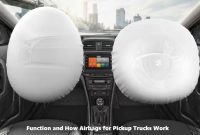Driving safety is a top priority, both for drivers and passengers. In this case, passive safety features are present to increase safety which is equipped with several important parts. The presence of various passive features makes the driving experience more protected, thus minimizing the risk of accidents that may occur.

A Series of Passive Safety Features That Must Be Known
The existence of passive features is designed to protect passengers in the event of an accident. In practice, this feature works automatically by minimizing the impact of injury to the driver and passengers, when a collision occurs.
Airbag
The airbag feature functions to protect the driver and passengers, if various unwanted things happen. In its application, this feature can inflate to protect the passenger’s head, neck, and chest from various impacts.
For information, the airbag will only be active if there is a collision at certain angles in the vehicle. When a hard impact occurs, the airbag is filled with nitrogen gas quickly, so that it acts as a “pillow” that absorbs kinetic energy. After a collision, this passive safety features will slowly lose pressure and deflate again.
According to the Sabin Civil Engineering YouTube channel, when an accident occurs, the airbag distributes the impact force to a wider area. In this case, the airbag inflates at a speed of up to 320 km/h. However, the effectiveness of airbag use is only guaranteed if the driver is wearing a seat belt. Without a seat belt, a direct impact with an inflated airbag can cause serious injury.
Seat Belt
The seat belt feature is designed to protect the driver and passengers from various serious injuries when an accident or collision occurs. In this case, when an accident occurs, the seat belt can hold the driver and passenger’s body so that it remains in the seat area.
This condition can prevent the driver and passenger’s body from hitting hard parts inside the vehicle. In addition, this feature also prevents the driver and passengers from being thrown out through the window or falling from the vehicle.
Safe Body Structure
Generally, a safe body structure is made of strong and impact-resistant materials. This safety feature is designed with a deformation zone that can absorb collision energy, and then channel it away from the passengers.
The existence of a safe body structure provides better protection against force and pressure when an accident occurs. Thus, this feature can help reduce the risk of serious injury to passengers in the vehicle.
Laminated Glass
Laminated glass is a passive safety features consisting of several thin layers of strong plastic. This feature is sandwiched between two layers of glass.
In practice, laminated glass plays a role in preventing glass from breaking into sharp shards during a collision or accident. Therefore, the presence of this feature can reduce the risk of serious injury caused by sharp glass fragments.
Collision Sensor
The collision sensor feature helps reduce the risk of serious injury during an accident. The collision sensor can help activate other passive features that can protect the driver and passengers from various collisions.
Passive safety features can provide extra protection for both the driver and passengers. This feature consists of airbags, seat belts, a safe body structure, laminated glass, and collision sensors. /Siti



